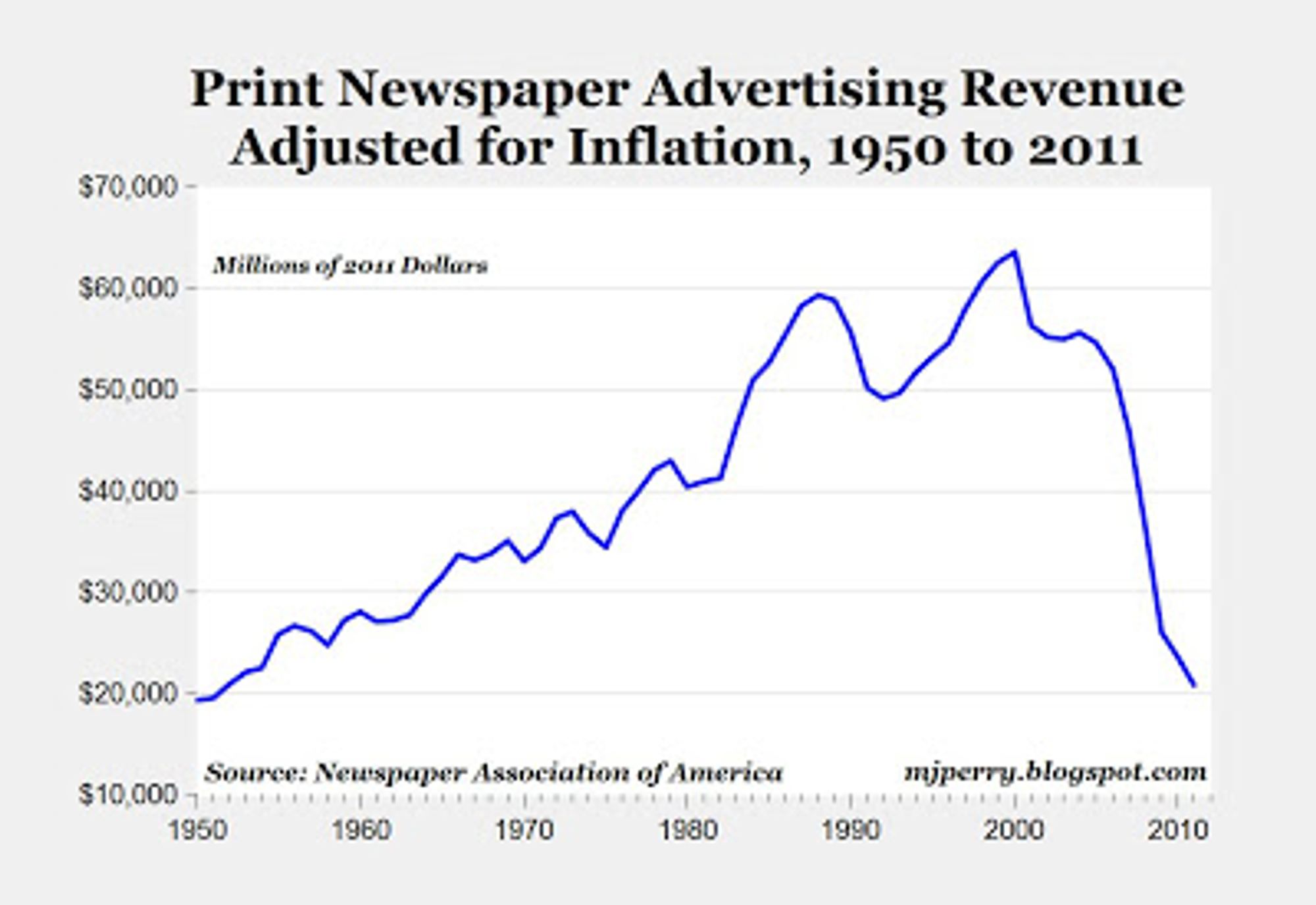The newspaper industry can survive - if it changes its mindset
date
Mar 1, 2012
slug
2012-widespread-bankruptcy-of-the-printed-need-need-not-mean-the-death-of-the-newspaper
status
Published
tags
changes
newspapers
business model
type
Post
ogImage
summary
The newspaper industry must adapt or face extinction as digital media and changing reader behavior reshape the landscape.
The chart below was published by the site The Atlantic. These curves are the geometric shapes that most terrify the gentlemen in charge of print-born journalistic companies (mostly from the 19th century onwards). There is not much to counter-argue in favor of maintaining print advertising when seeing these graphs and, in fact, it looks a lot like a death certificate for the vast majority of newspapers and a large number of magazines. But it's not. It's a warning. There's still time for those who want to save themselves.

The reading of the graph shows that print advertising grew until digital began to sweep the world of information delivery. The consolidation of this framework didn't happen before due to the explosion of the first Internet bubble at the beginning of the last decade ("first" because there should be a second). For a series of circumstances (printing cost, distribution, change in the news production cycle, generational behavior change, rigidity of journalistic company structures, etc), the print medium lost in efficiency as a support and the paper newspaper will disappear (there are serious estimates that by 2020 there will be no more paper newspaper as a mass communication medium, remaining only as support for niche activities or vintage (to use a very pedantic word).
However, the second chart published by The Atlantic brings information that is practically a lifebuoy for companies that can break their own rigidity to reshape their structures and rethink both the news cycle and their own environment. The only newspaper that managed to maintain its subscription base - and actually, expand it - was the newspaper that started to consider digital and print subscribers together, the Wall Street Journal. All the others lost subscribers catastrophically.
The good news for newspapers here is that yes, it is possible to migrate reader bases. The bad news is that the process has to be redesigned from end to end. There can be no more closing - news comes to life and needs to have immediate suites; the online newsroom and the newspaper newsroom cease to exist - everything MUST work together so that neither cannibalizes the other's work; there can be no "closed part" in the newspaper (which means to say that part of its content is better and part is worse; the Financial Times model, where heavy users are compelled to pay is much smarter); video and audio become indispensable, as long as they are part of the "thought" coverage and not a clumsy passage over a poorly done off). It seems difficult a project of this kind, but in fact it is almost impossible. Reversing certain cultures within a company is a very hard task.
But the truth is that there is no option. The paper support has become technologically outdated, but the death blows to print are the change of the 24-hour news cycle and the much greater efficiency of digital in tracking the profile of readers making ads more efficient and more expensive.
The "more expensive", of course, refers to the unitary ad. There is no comparison between what mass print advertising could cost and what digital ads cost, which have a much lower marginal cost and by being more efficient allow the advertiser (as long as the agency takes care of this advertiser's money) to spend less money for a greater result. Thus, without much difficulty, we arrive at what is the greatest difficulty of acceptance for newspapers: that they no longer have the ability to have the gigantic structures of yesteryear. Very large journalistic operations will be limited to a very restricted group of companies. This means having to dismiss a series of directors and executives with high salaries and who are very well connected. This cut is, comfortably, the hardest to make in this transition and what makes it more unlikely, even if the alternative is disappearance. Whoever doesn't want to give the rings to keep the fingers, will end up losing both.
The maxim is not only for newspapers, although the decline of advertising for TV, for example, is still slower and gives this media a much longer lifespan. Even so, there are broadcasters that are already trying to prepare to avoid future disruptions. Companies like British ITV have slowly started the revolution. ITV adapted its newsroom to produce multimedia material with its network of correspondents throughout the UK, including social media tools in their plans, redoing distribution contracts and investing in video on demand (VOD), invested money in improving its native video players, in facilitating payment for subscriptions or digital purchases and new subscription plans.
Large environmental changes make massive victims and not all individuals start thinking about their own survival at the same time. The entry of digital into the information medium is a change similar to the occurrence of the last ice age on Earth. Life was never threatened, but it had to rearrange itself in radically different ways. Today, in communication, betting on tradition is the shortest way to become a museum item and history book stuffing.